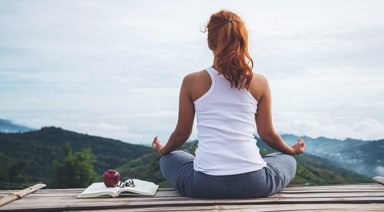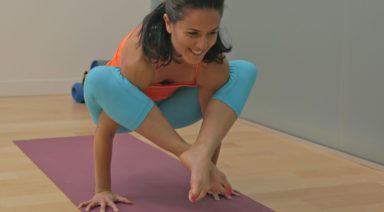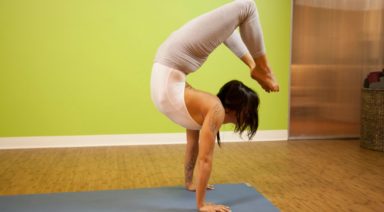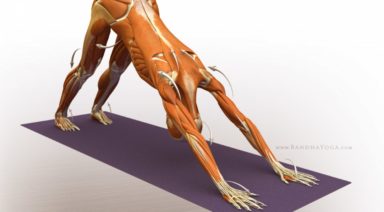Asana Anatomy Downward Facing Dog

If you’ve ever taken an Ashtanga or vinyasa flow class, Adho Mukha Svanasana, Downward Facing Dog, is no stranger to you. Downward Facing Dog is a fundamental yoga asana, but a surprisingly complex one. As my teacher recently joked, “If I hear one more instructor say the phrase – ‘ Downward Facing Dog is a resting pose’- I’ll shoot them!” Nothing is more daunting to a student on their 5th or 6th or 7th Downward Facing Dog to learn that they are supposed to be resting in this complicated pose. Learning about the anatomy of the pose can help us find a little more ease in the mystery that is Downward Facing Dog.
Let’s dissect this asana.
Setting the foundation
At the palms, our fingers are spread wide, distributing the weight evenly from the thumb side to the pinky finger side. This minimizes tension and discomfort in the wrists. There should be an ever so slight bend in the elbow, created by the biceps, avoiding hyperextension at the elbows. Imagine the eyes of your elbows (the crease) gently turning forward without changing the hands. This requires the pronator muscle of the forearm to engage the internal rotation of the lower arms, as the rotator cuff muscles (teres major and infraspinatus) turn the elbow eyes forward with outward rotation of the upper arms.
At the feet, our toes are spread wide, feet hip width apart. We should feel an equal amount of weight between the hands and the feet. For many students this means pressing firmly into the palms and allowing the hips to move up and back so that the heels can gracefully meet the floor. Be aware of any tendency to stay up on the balls of the feet, as this can aggravate the plantar fascia of the feet, resulting in an injury known as plantar fasciitis.
Strength in Stillness
Upper Body
As the upper arms roll out, the shoulder blades must be gliding onto the back. We want to avoid winging, or poking out of the lower pole of the shoulder blade. To engage the serratus anterior muscle eccentrically (active lengthening) that controls this gliding, we need to grow broad across the collarbone. Imagine the heart floating downward, opening the chest, and introducing the shoulder blades to each other by bringing the blades down and together on our backs, activating our triangle shaped trapezius muscle.
Core
Now expand through the inner body, growing long through the side body, lengthening the oblique muscles of the core and the intercostals muscles between the ribs. Imagine the space between each rib growing. Check in with your front ribs. The action of uddiyana bandha, tucking in and up of the belly button, flattens the lower belly engaging transversus abdominus, but should also bring the lower ribs in.
Lower Body
As the hips move up and back, imagine an inward spiral of the groin muscles. Keeping that inward rotation, gently tuck the tailbone under, aiding the engagement of the transversus abdominus. The adductor muscles of the inner thighs move towards each other, as if holding a block between the thighs. Lengthen from the attachment of the hamstrings at the sitting bone, all the way through the gastroc and soleus muscles of the calves. There is a co-ordinated opposite action here of active lengthening through the calves, countered by the active dorsi flexion of the foot by the tibialis anterior on the front of the shin.
Benefits & Considerations
Downward Facing Dog requires a lot of openness through the chest and shoulders. If you are unable to raise your arms to at least the level of your face, you should consider one of the variations below.
-
Childs pose / Balasana: Sitting back on your heels, stretch your arms out in front of you. Use the same action of the arms as above, but childs pose allows you to control the influence of gravity without over extending at the shoulders
-
Modified Downward Facing dog at the wall: Stand in front of the wall with your hands on the wall, shoulder width, slightly below shoulder height. Keeping your feet hip distance, slowly back away from the wall, using the same principles of alignment as above but slowly moving into an open chest and shoulder girdle.
If you are unable to correct a pinching sensation in the front of your shoulder, it is possible you may have impingement in your shoulder joint and should consult a health practitioner familiar with yoga. Conversely, because Downward Facing Dog requires this level of openness through the shoulders it can be a great shoulder and chest opener. It is important that we do not sag into the anatomy however. We must keep the active actions in the shoulders, then once aligned, open to the pose. Downward Facing Dog can also be a source of relief for people with mid-back or lower back pain. The muscles that attach from the skull to the pelvis, the erector spinae group, are lengthened actively. In addition, with the arms overhead in this position, the latisimus dorsi muscles, attaching from the ribs and fascia of the lower spine into to the arms, are lengthened.
Now Breathe
Downward Facing Dog is foundational pose that brings us back to our centre. It can act as our home base, where we check in with our alignment in a very active and functional way. There are few poses more powerful than a well-aligned Downward Facing Dog that is fueled by a steady flow of breath.
Virabhadrasana II: Warrior II Pose

ADJUSTMENTS | BENEFITS | SEQUENCING | SANSKRIT | STEPS
Warrior II, or virabhadrasana (veer-ah-bah-DRAHS-anna) II, is a strengthening pose that improves physical and mental endurance. Its ability to stretch your upper legs and ankles while also expanding your chest and shoulders makes it an essential foundational pose for most asana-based (pose-based) yoga practices.
Philosophy + Origin
While warrior II is a strong pose, it also requires balance and steadiness. Although many origin stories for virabhadrasana II describe the shape of the pose as the stance Virabhadra took as he drew his sword to remove the head of his enemy, any student who has practiced the pose will learn that, while fierce, there’s also a gentleness within the physical lines. The yogic philosophy of sthira sukha, or balancing effort with ease, can be applied when practicing warrior II. How can you harness your warrior spirit while not losing sight of your gentle spirit and your commitment to ahimsa, non-violence?





































